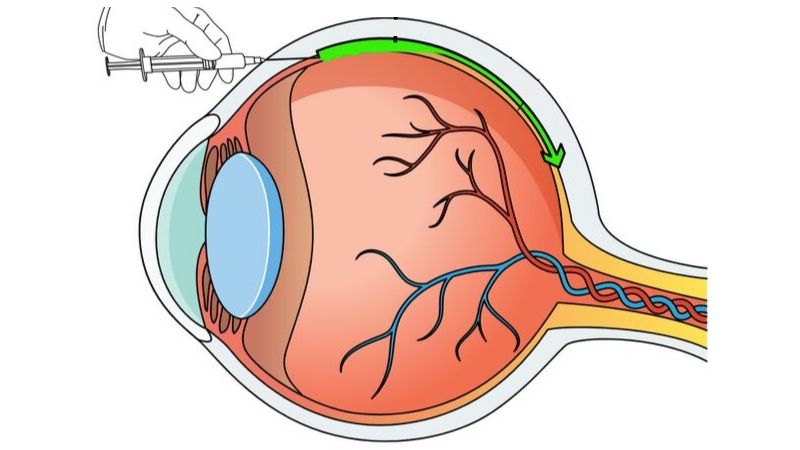NIBIB-funded researchers have created nanoparticles for successful gene therapy of a mouse model of macular degeneration. The nanoparticle carriers have the potential to significantly expand the growing repertoire and effectiveness of gene therapies for human eye diseases, including blindness.
A number of eye diseases have benefited from gene therapies where DNA coding for therapeutic proteins is delivered to cells in the eye. Current therapies deliver the DNA using viral vectors, but this method has limitations, including the development of an immune response against the viral carrier and limits to the size of gene that will fit in the virus.
Engineers and ophthalmologists have teamed up to address the limitations of viral vectors in the treatment of blinding eye diseases such as wet age-related macular degeneration (AMD). Wet AMD is a common disease characterized by abnormal blood vessel growth that damages the light-sensitive tissue in the back of the eye.
The research team at the Johns Hopkins University School of Medicine was led by Jordan Green, Ph.D., Professor of Biomedical Engineering, Ophthalmology, Oncology, Neurosurgery, Materials Science & Engineering, and Chemical & Biomolecular Engineering, and Peter A. Campochiaro, M.D., Director, Retinal Cell and Molecular Laboratory and George S. and Dolores Dor Eccles Professor of Ophthalmology and Neuroscience.
“This is an outstanding collaboration combining Dr. Green’s work in creating nanoparticles for gene delivery and Dr. Campochiaro’s expertise in retinal diseases,” said David Rampulla, Ph.D., Director of the NIBIB program in Synthetic Biological and Biomimetic Systems. “The system they have created promises to reduce the debilitating effects of eye disease and preserve eyesight by inhibiting disease progression.”
“We’ve been able to use gene therapy to treat eye disease because the eye is very accessible and takes up the viruses carrying the therapeutic gene quite readily,” explains Campochiaro. ”However, expression of the therapeutic protein eventually fades, requiring repeated injections of the gene-carrying virus to maintain adequate levels of the therapeutic protein.”
Repeat treatments are problematic in that it means frequent eye injections for patients. And subsequent rounds of treatment are often unsuccessful because the immune system of the patient has developed antibodies that attack and neutralize the gene-carrying virus.
That is where Green’s nanoparticle technology comes in. Nanoparticles are virtually undetected by the immune system and there is no apparent development of antibodies that would attack the particle in a subsequent treatment. Another desirable characteristic is that the nanoparticles can carry therapeutic genes that are too large to be carried by viral vectors.
The team performed a number of experiments in rats and mice showing that the nanoparticles very efficiently carried genes into the cells of the eye and made large quantities of protein. The proteins continued to be made for at least eight months, a significant improvement over current treatments where therapeutic proteins must be injected directly every 1-2 months.
One test was conducted using a gene that makes vascular endothelial growth factor (VEGF). VEGF induces the growth of new blood vessels in the eye. If there is a lot of VEGF there is an overproduction of blood vessels that extend into the retina and block vision, which is what happens in people with wet AMD.
The researchers injected the eyes of 30 rats with the nanoparticles carrying the VEGF gene. The rats developed abnormal blood vessels one month after the injection. The abnormal blood vessels were more extensive at two and five months after injection, and there was scarring under the retina similar to that seen in untreated wet AMD patients. This validated the efficacy and durability of the gene therapy system for creation of animal models.
The therapeutic potential of the delivery system was tested by delivering a nanoparticle carrying a gene that makes a protein that inhibits VEGF.
The inhibiting nanoparticle was injected into a mouse model of wet AMD, which features the overproduction of abnormal blood vessels seen in the disease in humans. Three weeks after injecting nanoparticles containing the gene for the VEGF-inhibiting protein, the mice had a 60% reduction in abnormal blood vessels when compared to control mice.
“These results are extremely promising,” said Green. “We’ve shown that the nanoparticles have the potential to deliver genes that produce active therapeutic proteins for many months.” The result is a considerable improvement over the current therapy of injecting the therapeutic protein directly, which requires repeated injections every month or so. The lack of an apparent immune response to the nanoparticles is also a significant improvement over gene therapy with viral vectors.”
The team is now working on using the nanoparticle system to treat patients with reduced or no vision due to genetic defects where blindness occurs because of a defective inherited gene. They are hopeful that the robust gene expression seen with their nanoparticles will allow them to introduce functional versions of genes that inherited mutations have disabled — and restore vision.
The work is reported in the July issue of the journal Science Advances1.
The research was supported by grant EB022148 from the National Institute of Biomedical Imaging and Bioengineering, grants EY031097, EY026148, EY028996 and EY01765 from the National Eye Institute; the Dr. H. James and Carole Free Catalyst Award and unrestricted grant from Research to Prevent Blindness; the Louis B. Thalheimer Translational Fund; a grant from the Barth Foundation; a scholarship to J.K. from Samsung; and unrestricted grants from Conrad and Lois Aschenbach, Per Bang-Jensen, Andrew and Yvette Marriott, and Jean Lake.
Original post https://alertarticles.info
